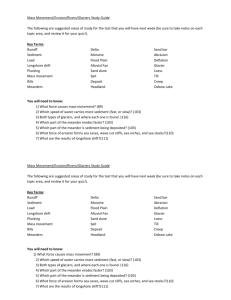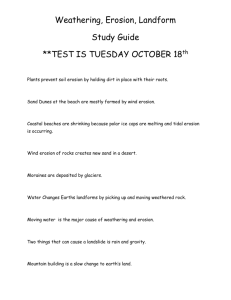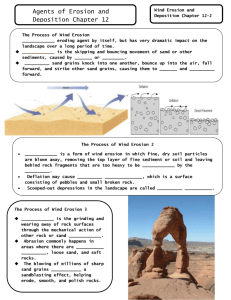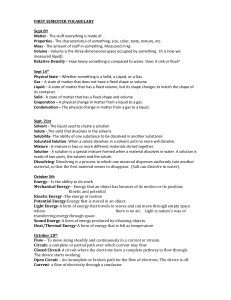Extreme Storms on the Pacific Northwest Coast
advertisement
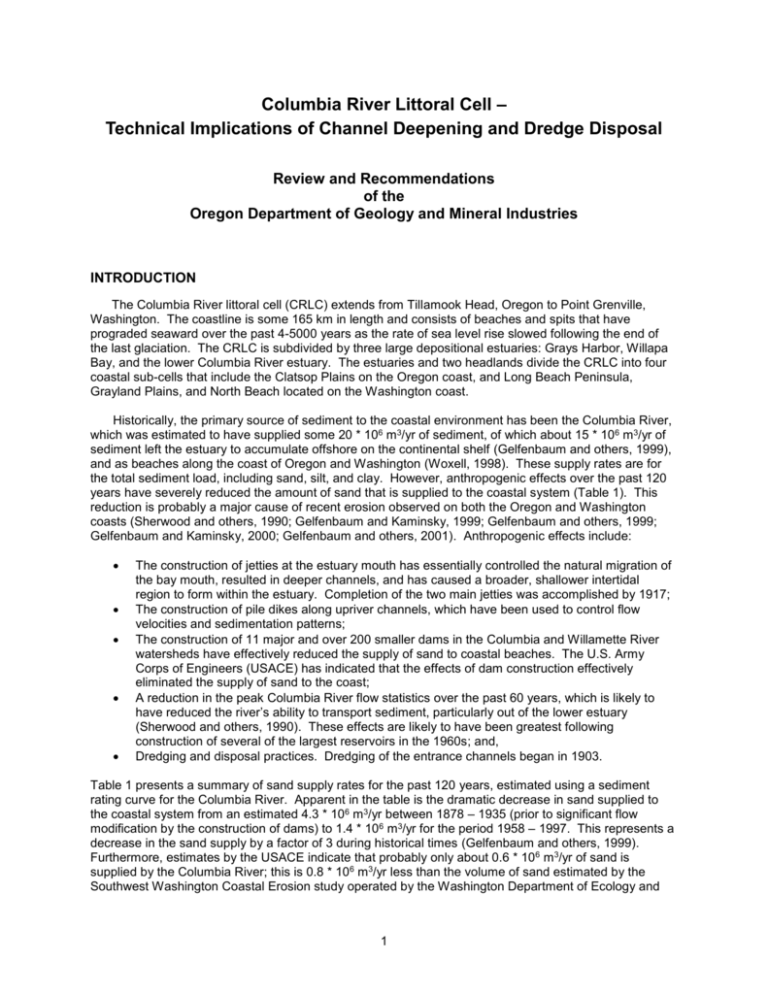
Columbia River Littoral Cell – Technical Implications of Channel Deepening and Dredge Disposal Review and Recommendations of the Oregon Department of Geology and Mineral Industries INTRODUCTION The Columbia River littoral cell (CRLC) extends from Tillamook Head, Oregon to Point Grenville, Washington. The coastline is some 165 km in length and consists of beaches and spits that have prograded seaward over the past 4-5000 years as the rate of sea level rise slowed following the end of the last glaciation. The CRLC is subdivided by three large depositional estuaries: Grays Harbor, Willapa Bay, and the lower Columbia River estuary. The estuaries and two headlands divide the CRLC into four coastal sub-cells that include the Clatsop Plains on the Oregon coast, and Long Beach Peninsula, Grayland Plains, and North Beach located on the Washington coast. Historically, the primary source of sediment to the coastal environment has been the Columbia River, which was estimated to have supplied some 20 * 106 m3/yr of sediment, of which about 15 * 106 m3/yr of sediment left the estuary to accumulate offshore on the continental shelf (Gelfenbaum and others, 1999), and as beaches along the coast of Oregon and Washington (Woxell, 1998). These supply rates are for the total sediment load, including sand, silt, and clay. However, anthropogenic effects over the past 120 years have severely reduced the amount of sand that is supplied to the coastal system (Table 1). This reduction is probably a major cause of recent erosion observed on both the Oregon and Washington coasts (Sherwood and others, 1990; Gelfenbaum and Kaminsky, 1999; Gelfenbaum and others, 1999; Gelfenbaum and Kaminsky, 2000; Gelfenbaum and others, 2001). Anthropogenic effects include: The construction of jetties at the estuary mouth has essentially controlled the natural migration of the bay mouth, resulted in deeper channels, and has caused a broader, shallower intertidal region to form within the estuary. Completion of the two main jetties was accomplished by 1917; The construction of pile dikes along upriver channels, which have been used to control flow velocities and sedimentation patterns; The construction of 11 major and over 200 smaller dams in the Columbia and Willamette River watersheds have effectively reduced the supply of sand to coastal beaches. The U.S. Army Corps of Engineers (USACE) has indicated that the effects of dam construction effectively eliminated the supply of sand to the coast; A reduction in the peak Columbia River flow statistics over the past 60 years, which is likely to have reduced the river’s ability to transport sediment, particularly out of the lower estuary (Sherwood and others, 1990). These effects are likely to have been greatest following construction of several of the largest reservoirs in the 1960s; and, Dredging and disposal practices. Dredging of the entrance channels began in 1903. Table 1 presents a summary of sand supply rates for the past 120 years, estimated using a sediment rating curve for the Columbia River. Apparent in the table is the dramatic decrease in sand supplied to the coastal system from an estimated 4.3 * 106 m3/yr between 1878 – 1935 (prior to significant flow modification by the construction of dams) to 1.4 * 106 m3/yr for the period 1958 – 1997. This represents a decrease in the sand supply by a factor of 3 during historical times (Gelfenbaum and others, 1999). Furthermore, estimates by the USACE indicate that probably only about 0.6 * 106 m3/yr of sand is supplied by the Columbia River; this is 0.8 * 106 m3/yr less than the volume of sand estimated by the Southwest Washington Coastal Erosion study operated by the Washington Department of Ecology and 1 the US Geological Survey. One caveat concerning the volume estimates provided in Table 1 is that they do not account for possible reductions in sand supply due to variations in climate or as a result of irrigation and changing land use practices. Nevertheless, the secular decrease in the supply of sand to the coast represents a significant shift in the overall equilibrium of the system. Table 1 Estimates of total sediment and sand volume yields for the Columbia River for pre- and post-dam construction (Gelfenbaum and others, 1999). Period Pre-dam construction Post-dam construction Significant flow modification after mid-1960s Total Sediment Volumes 8.7 * 106 m3/yr 1878 - 1934 1934 - 1958 1958 - 1997 4.3 * 106 m3/yr Sand Supply Volumes 4.3 * 106 m3/yr 2.6 * 106 m3/yr 1.4 * 106 m3/yr Human effects in the coastal system are most apparent around the mouth of the Columbia River, where construction of jetties caused the coastline to prograde seaward by hundreds of meters. However, these changes were not a constant process, and varied due to the different phases of jetty construction, including the construction of the north jetty, and their subsequent maintenance and modification (Lockett, 1963). Following construction of the south jetty in 1902, Clatsop Spit grew northwards by about 4.6 km during a period of 50 years. A likely source of the sand that accumulated along Clatsop Spit was due to changes in the Columbia River inlet, which resulted in the development of shoals along the north side of the south jetty, and possibly from erosion of the mid-continental shelf region offshore from the Clatsop Plains. Analyses by Gelfenbaum and others (2001) indicated that between the 1870s and 1926 the midcontinental shelf region and the inlet mouth lost about 364 million m 3 of sand (Figure 1). However, the growth of Clatsop Spit was not without its problems. For example, the westward expansion of the Clatsop Plains forced the Columbia River channel northwards. This process eventually eroded a shoal area that protected the north jetty, which ultimately resulted in the jetty being damaged (Lockett, 1963). Figure 1 Estimated sand volume changes identified adjacent to the Columbia River for the period 1868 –1926 (Gelfenbaum and others, 2001). 2 Between 1926 and the 1950s, the northern end of Clatsop Spit eroded by some 200 to 250 m (650 to 820 ft). This response is probably related to ongoing erosion of the mid-continental shelf region offshore from Clatsop Spit throughout this period; the product of reduced sand supplies from the Columbia River and possible dredging and disposal practices that commenced in the Columbia River. In contrast, the central part of the Clatsop Plains prograded significantly (total accumulation of 60 million m 3 of sand) throughout this period. Since the 1950s erosion of the spit appears to have stabilized somewhat. However, recent analyses using LIDAR, aerial photography, and beach surveys indicate that the central and northern Clatsop Plains continue to experience some erosion, while accretion dominates the southern end of the cell (Ruggiero and Voigt, 2000). Because of ongoing erosion offshore from Clatsop Spit and erosion adjacent to the spit tip, the USACE is now concerned that part of the south jetty may eventually be undermined through toe erosion. In addition, because the northern tip of Clatsop Spit is only 380 - 700 m (1200 - 2300 ft) wide, there are also concerns that this section of the spit could be breached, which would result in the formation of a second river mouth. The potential for spit breaching near the south jetty was noted as early as the late 1950s. For example, Lockett (1963) suggested that the spit could be overtopped so that a complete breach to the lagoon in the rear of the shore may occur at any time. Although such a breach has not eventuated, it remains a distinct possibility. Accordingly, the Corps has recently re-introduced an option to dispose of dredged sediments in the nearshore, offshore from Clatsop Spit (U.S. Corps of Engineers Public Notice, 21 December 2001). It is the expectation that these sediments will then move onshore to re-nourish beaches along northern Clatsop Spit. More compelling evidence for the potential for future erosion along the Clatsop Plains is the ongoing loss of sediment (albeit at decreasing rates) offshore from the coastline (Figure 2). This loss of material has been further substantiated in a recent study of sediment transport patterns adjacent to the Columbia River (McLaren and Hill, 2001). The study by McLaren and Hill (2001) clearly shows that the midcontinental shelf and nearshore region offshore from the Clatsop Plains is presently loosing sediment (i.e. acting as a source of sediment), and that the sediment is being transported northwards along the coast and into the lower Columbia River estuary. These findings are consistent with similar conclusions reached by the Southwest Washington Erosion Study. The ongoing erosion on the mid-continental shelf and in the nearshore reinforces the conclusion that the Columbia River littoral system is starved of sediment. These changes point toward a deepening of the bathymetry offshore from the Clatsop coastline, which could have important implications for the future stability of the coast and the south jetty. These implications include: 1. The amount of energy lost through wave shoaling may be less in the future than has been experienced in the past (i.e. the nearshore and mid-shelf region may not be as efficient at dissipating wave energy as it was in the past); 2. The turbulent process of wave breaking, which causes sediments to be entrained and transported, may occur closer to shore, which could result in an increase in shoreline erosion; and, 3. The south jetty may experience undermining, and/or the northern end of Clatsop Spit may breach. Given the general decline in the ability of the Columbia River to discharge sediments to the coast, sand eroded from the Clatsop Plains, nearshore, and mid-shelf regions may now constitute a significant source of beach sediment to the Columbia River littoral system. In contrast, on the Oregon side there is probably no comparable source of sediment to the Clatsop Plains, other than: sand that is eroded from Clatsop County beaches or, sand that may be transported in the summer as littoral drift, or as a result of wind processes. Few attempts have been made to properly quantify the patterns of net sediment movement along the coasts of Oregon and Washington. Furthermore, there remains some disagreement among coastal geologists about the predominant directions of net sand movement. Accordingly, there is little knowledge of the volumes of sand that can be moved seasonally along the coast, or that can be moved as a result of 3 climate events such as the El Niño climate phenomenon. For example, El Niños typically produce a net northward shift of sands, while the southern ends of the littoral cells experience increased coastal erosion (Komar, 1986, 1998). During subsequent “normal” years, the sand is returned to the south so that the net sand transport is close to zero. Net sand transport effects associated with progressive long term increases in wave heights and storm frequency have also not been established (Allan and Komar, 2000; Graham and Diaz, 2001; Allan and Komar, in review). Nor has the effects of the Pacific Decadal Oscillation (PDO), which causes interdecadal (10-30 year) climate shifts been properly assessed (Mantua and others, 1997). This latter process is likely to be important since a warm PDO phase contributes to an increase in the incidence of El Niños, and hence greater sand transport to the north, while the cold PDO phase results in predominantly La Niña type conditions. Thus, it is apparent that sand transport may vary significantly at time scales ranging from a few years to perhaps a few decades. Although such processes influence the budget of sediments over periods of 1 – 30 years, and may account for some of the erosion observed along the coasts of Oregon and Washington, the progressive decline in sand supplied to the coast due to changes to the Columbia River, remains by far the primary cause of long term shoreline changes identified along the Columbia River littoral cell. Figure 2 Estimated sand volume changes identified adjacent to the Columbia River for the period 1926 – 1958, and 1958 – 1997 (Gelfenbaum and others, 2001). HISTORIC AND PROPOSED DREDGING PRACTICES Dredging of the Columbia River channel began in the early 1900s several years after the south jetty was constructed. Between 1909 and 1939 an estimated 145 * 106 m3 of material was dredged from the system between the river mouth and Portland (Sherwood and others, 1990). The removal of these sediments was mainly associated with the construction of the navigation channel, and its subsequent maintenance. Sherwood and others (1990) indicate that much of this material was removed from the estuary, with the bulk of the sand having been placed offshore adjacent to an existing disposal site located southwest of the south jetty (USCE, 1999). 4 Between 1939 and 1981, about 75 * 106 m3 of material was dredged inside the river mouth, all of which was deposited outside of the jetties. Furthermore, the amount of material dredged around the mouth of the Columbia River increased from about 1.7 * 106 m3 annually between 1958 and 1975, up to about 4.5 * 106 m3 annually by the early 1980s (Sherwood and others, 1990). It is interesting to speculate whether such changes were due to the transition from predominantly La Niña conditions prior to 1976 to the more recent period dominated by El Niños, conditions that tend to be characterized by a predominantly net northward drift of sediment. Furthermore, these types of processes may account for some of the large interannual variability in the volumes of sediment that have been dredged from the river channel and around the mouth over the years. Since 1939, an additional 50 - 100 * 106 m3 of material was removed from the system in the form of land disposal, including the formation of several islands (e.g. Rice Island and Miller Sands) in the Columbia River. Throughout the 1990s the USACE continued to dump on average ~3.5 - 3.8 * 106 m3/yr of sediment in the various ocean disposal sites available to them (USCE, 1999). This recent dredging practice relates to the ongoing maintenance of the navigation channel adjacent to the river mouth, and the decision to deepen the main channel to ~16.7 m (55 ft). Given the above figures, the long term net removal of sediment from the Columbia River littoral system amounts to some 2.5 * 106 m3/yr for the period 1939 to 1999, which represents a total loss of some 150 * 106 m3 of sand from the system. From the standpoint of shore stability a major concern with existing disposal practices is that the bulk of the sediment is being dumped in water too deep to allow for its return to the nearshore (Shepsis, 2000 in Gelfenbaum and Kaminsky, 2000). As a result, the sediment is permanently lost from the littoral system and cannot be returned naturally to supply the beaches of Oregon and Washington. Under the proposed deepening and maintenance project intended to run for the next 20 years, the USACE would continue to remove substantial volumes of additional sediment. This would include: 47.7 * 106 m3 of sand to be removed from the navigation channel (i.e. river sand); 12.2 * 106 m3 of sand to be removed from the lower Columbia River estuary; and, 30.6 - 53.5 * 106 m3 of sand to be removed adjacent to the mouth of the river. These figures represent an additional 90.5 – 113.4 * 106 m3 of sand to be removed as a result of further channel construction and maintenance, at an extraction rate of around 4.5 – 5.7 * 106 m3/yr for the next 20 years. When compared with the amount of sand presently estimated to supply the coast (Table 1), it is apparent that these rates are some 3.2 – 4 times greater than the present supply of sand from the river. The bottom line is that unless we begin to correct the present sediment imbalance, we are likely to see much greater coastal erosion problems during the next 10 through 100 years, along both the Oregon and Washington coasts. CONCLUSIONS During the past 120 years the Columbia River littoral system has been extensively modified in response to the construction of dams and jetties. These modifications have caused a number of important changes to the hydrodynamics of the fluvial and estuarine system, including a significant reduction in the peak river flow statistics that has resulted in an increase in the trapping efficiency of the lower Columbia River (estuary), so that the estuary now constitutes a sediment sink as opposed to a source of sand as it did prior to human intervention, and the trapping of large quantities of sand behind the dams. As a result of these changes, concerns have been raised about the implications of such human impacts, particularly in terms of the future viability of the coastal environment both in terms of fisheries and coastal erosion. It is probable that the existing disposal practices adopted by the USACE are unsustainable, since the bulk of the sand that is disposed of offshore is placed in deep water, where it cannot return to the littoral environment to supply the beaches of Oregon and Washington, or is placed in 5 upland disposal sites. There are a few exceptions. For example, the USACE presently maintains nearshore disposal sites within the estuary and adjacent to the north jetty, and offshore from the north jetty (site E). However, it is uncertain whether these sites are suitable for supplying sediments to the beaches of Oregon. In addition, there is little convincing evidence to indicate that the Site E disposal site is even supplying sediments to the beaches of southern Washington, since much of the material that is being dispersed appears to remain offshore. Finally, sand eroded from the Clatsop Plains, nearshore, and mid-shelf regions may now constitute a significant source of beach sediment to the Columbia River littoral system. Without further analyses and ongoing monitoring of the Clatsop Plains, it is not clear whether the present erosion will continue, accelerate, or even expand further south along the coast. There are several other technical issues that need to be noted: There is consensus amongst scientists, including those within the USACE, that there is a lack of quantitative information on patterns of sedimentation and erosional processes around the mouth of the Columbia River and in the estuary; There is little precise information regarding how much sand, passes through the estuary mouth to the coast. The consensus (including a USACE hydrologist) is that probably very little sand passes out of the estuary to supply the beaches of Oregon and Washington. Thus, it is probable that the supply of sand to the coast has been effectively reduced or cut off altogether by the combination of jetties and dredge disposal practices, while the estuary has become a sink for sediments (Lockett, 1963). Furthermore, we regard a recent claim by a USACE hydrologist that the Columbia River probably never really supplied significant quantities of material to the coast as incorrect. The USACE contends that there is no real sediment (sand) issue associated with the Columbia River. The argument is based on two positions to which counter-arguments are offered in the present environment of insufficient data: o Position One: Because the present system cannot discharge sand to the coastal environment, the future extraction of more sediment as a result of the channel deepening project and ongoing maintenance is justified. Such actions according to this concept would not affect the amount of sediment present in the coastal system because sand does not get out of the estuary. Counter argument: While this may be the case under the present conditions, it has certainly never been the case historically. This is a circular argument that overlooks significant additional considerations as seen below. Furthermore, channel deepening and maintenance dredging adjacent to the river mouth and in the estuary may in fact enhance the estuary’s contemporary role as a sink for beach sand. o Position Two: There are considerable volumes of sand within the river and lower estuary that are unlikely to run out in the foreseeable future. The removal of the volumes of material touted for the channel deepening project and for its ongoing maintenance is negligible compared with the overall volume of sand stored in the Columbia River and its estuary. Counter argument: Concerns could be raised over the loss of these sediments from the overall system. In particular, there is evidence to suggest that although sediment does not leave the estuary to supply the coast, sand does come into the estuary from the offshore ocean environment (Lockett, 1963; Sherwood and others, 1990). This claim is substantiated in the recent study by McLaren and Hill (2001), although the study does not establish the volumes of sediment that are being moved through the river mouth and into the estuary. These sediments are transported in on the flood tide, and over time accumulate in the main channel and elsewhere. Thus, any extraction of sand adjacent to the river mouth and navigation channel does constitute a net loss of sand from the coastal system since it continues to deplete sand from an already starved coastal system. Because of the lack of information on the volumes of sand that enters the estuary through the mouth of the Columbia River, this is probably one of the main reasons why further studies should be carried out to better establish the transport hydrodynamics adjacent to the river mouth. 6 Recently, the USACE released a public notice (21 December 2001) outlining new approaches for dealing with the erosion problem along the Clatsop Plains, and for the coast of Washington. This proposal provides for two new nearshore disposal sites to be located offshore from the south jetty off Clatsop Spit, a pilot study to place sand (beach renourishment) directly on Benson beach, Washington, and a new nearshore disposal site to be located offshore from Peacock Spit on the Washington coast. These additional disposal sites are certainly a step in the right direction, providing they are located in sufficiently shallow water depths so the sediments are likely to end up on the beaches, and efforts are made to keep the sediments in the nearshore. One possible concern relates to the choice of the Clatsop Spit site. Based on the work of McLaren and Hill (2001) it is possible that the site chosen by the USACE off Clatsop Spit may end up supplying sand to the estuary rather than reaching the beaches along Clatsop Spit due to the presence of a northward flowing current in this area. More detailed information is needed about the choice of this site. Whatever decision is made concerning both the nearshore and deep water disposal sites and the channel deepening project, it is essential that the disposal sites and beaches be monitored carefully by detailed bathymetric and subaerial surveys. This would include monitoring of the lower Columbia estuary, to address various important questions that relate to sediment residence times in the estuary. In addition, due to the lack of scientific data on the volumes of sand that pass through the mouth of the Columbia River, further studies should be carried out to better establish the transport hydrodynamics adjacent to the river mouth and within the estuary. This review has highlighted the need for more information and data, particularly in regard to addressing core issues that relate to sediment residence times in the estuary. These issues have not been adequately assessed by the USACE, or as part of the Southwest Washington Erosion Study. Acquisition of this data would aid in the effective management of this part of the Oregon-Washington Coastline regardless of which policy calls are made on the issue of deepening. RECOMMENDATIONS We recommend that the USACE: 1. Give high priority to the use of nearshore dredge disposal sites that can be shown to effectively nourish beaches along the coasts of Oregon and Washington. The objective here is to regain as much of the natural (pre-jetty/pre-dam) contribution of sand as possible to these beaches. 2. Support a partnership with both the states of Washington and Oregon to quantify fluxes of sediment through the Columbia River mouth and between adjacent littoral systems. Monitoring of sediment transport from nearshore dredge spoil sites into the littoral system will be a key part of this effort. If such sites are implemented, then it is imperative that their effectiveness in nourishing the beaches be carefully monitored over the long term. The Oregon Department of Geology and Mineral Industries can aid in this effort by monitoring beach changes on the Clatsop Plains. We trust that similar expertise can be found in our counterparts in the State of Washington. Such monitoring and complementary offshore investigations (e.g. repeated bathymetric surveys) should be directly supported by the USACE Columbia River project. 7 References Allan, J.C. and P.D. Komar, 2000, Are ocean wave heights increasing in the eastern North Pacific?: EOS, Transaction of the American Geophysical Union, 47: 561-567. Allan, J.C. and P.D. Komar, in review, Wave climate change and coastal erosion in the US Pacific Northwest: WAVES 2001 - Fourth international symposium on ocean wave measurement and analysis, Amer. Soc. Civ. Engrs. Gelfenbaum, G., M.C. Buijsman, C.R. Sherwood, H.R. Moritz and A.E. Gibbs, 2001, Coastal evolution and sediment budget at the mouth of the Columbia River, USA: 4th International Conference on Coastal Dynamics, Lund, Sweden. Gelfenbaum, G. and G.M. Kaminsky, 1999, Southwest Washington coastal erosion workshop report 1998: Washington Department of Ecology, Olympia, WA, and U.S. Geological Survey, Menlo Park, CA, OFR 99-524, 182. Gelfenbaum, G. and G.M. Kaminsky, 2000, Southwest Washington coastal erosion workshop report 1999: Washington Department of Ecology, Olympia, WA, and U.S. Geological Survey, Menlo Park, CA, OFR 00-439, 187. Gelfenbaum, G., C.R. Sherwood, C.D. Peterson, G.M. Kaminsky, M.C. Buijsman, D.C. Twichell, P. Ruggiero, A.E. Gibbs and C. Reed, 1999, The Columbia River cell: A sediment budget overview: Proceedings of Coastal Sediments '99, Hauppauge, Long Island, New York, American Society of Civil Engineers: 1660-1675. Graham, N.E. and H.F. Diaz, 2001, Evidence for intensification of North Pacific Winter Cyclones since 1948: Bulletin of the American Meteorological Society, 82: 1869-1893. Komar, P.D., 1986, The 1982-83 El Nino and erosion on the coast of Oregon: Shore and Beach, 54(2): 312. Komar, P.D., 1998, The 1997-98 El Niño and erosion on the Oregon coast: Shore & Beach, 66(3): 33-41. Lockett, J.B., 1963, Phenomena affecting improvement of the lower Columbia estuary and entrance: Federal Interagency Sedimentation Conference, U.S. Department of Agriculture: 626-668. Mantua, N.J., S.R. Hare, Y. Zhang, J.M. Wallace and R.C. Francis, 1997, A Pacific interdecadal oscillation with impacts on salmon production: Bulletin of the American Meteorological Society, 78: 1069-1079. McLaren, P. and S. Hill, 2001, A sediment trend analysis (STA®) and an acoustic bottom classification (ABC) in the mouth of the Columbia River: Implications to dredge disposal operations and coastal erosion: Geosea® Consulting (Canada) Ltd, Brentwood Bay, BC, Canada: 20. Ruggiero, P. and B. Voigt, 2000, Beach monitoring in the Columbia River littoral cell, 1997-2000: Publication No. 00-06-026, Coastal Monitoring & Analysis Program, Washington Department of Ecology, Olympia, WA: 113. Sherwood, C.R., D.A. Jay, R.B. Harvey, P. Hamilton and C.A. Simenstad, 1990, Historical changes in the Columbia River Estuary: Progress in Oceanography, 25: 299-352. USCE, 1999, Integrated feasibility report for channel improvements and environmental impact statement: Columbia and Lower Willamette Rivers navigation channel, Oregon and Washington: U.S. Army Corps of Engineers, Portland, Oregon: Vol. 1. Woxell, L.K., 1998, Prehistoric beach accretion rates and long-term response to sediment depletion in the Columbia River littoral system, USA: M.S., Portland State University, Portland, OR: 206. 8


